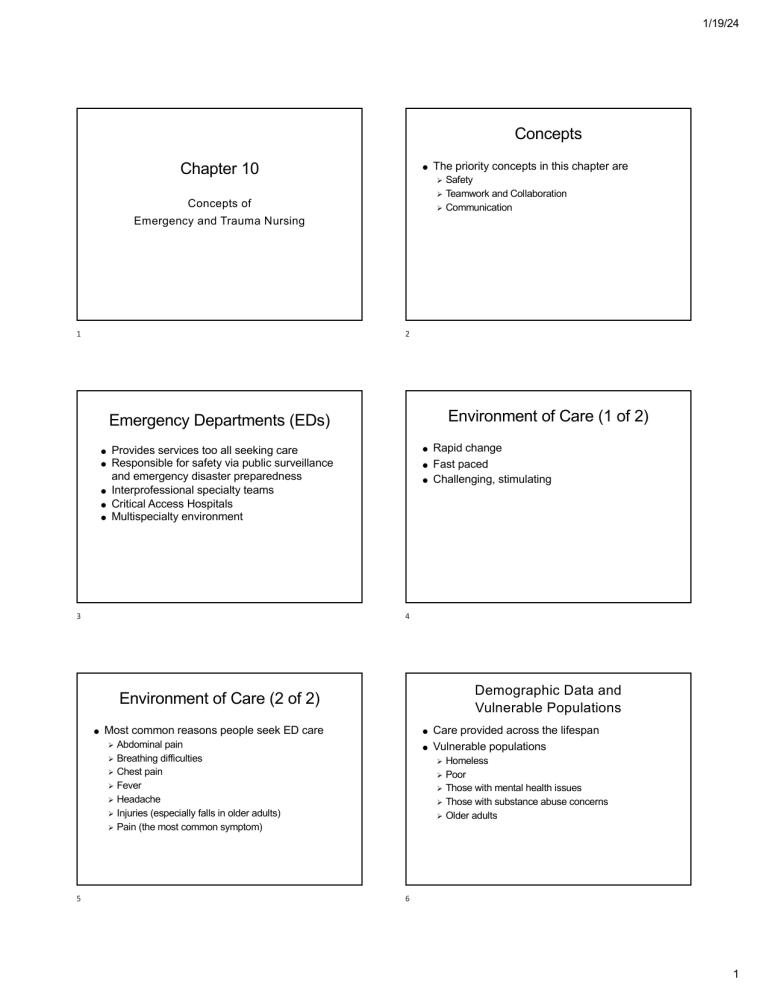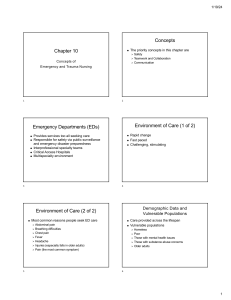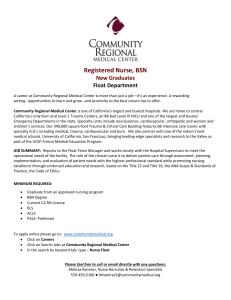
1/19/24 Concepts Chapter 10 The priority concepts in this chapter are Safety Teamwork and Collaboration Ø Communication Ø Ø Concepts of Emergency and Trauma Nursing 1 2 Environment of Care (1 of 2) Emergency Departments (EDs) Provides services too all seeking care Responsible for safety via public surveillance and emergency disaster preparedness Interprofessional specialty teams Critical Access Hospitals Multispecialty environment 3 Rapid change Fast paced Challenging, stimulating 4 Demographic Data and Vulnerable Populations Environment of Care (2 of 2) Most common reasons people seek ED care Abdominal pain Ø Breathing difficulties Ø Chest pain Ø Fever Ø Headache Ø Injuries (especially falls in older adults) Ø Pain (the most common symptom) Ø 5 Care provided across the lifespan Vulnerable populations Homeless Poor Ø Those with mental health issues Ø Those with substance abuse concerns Ø Older adults Ø Ø 6 1 1/19/24 The Impact of Homelessness (1 of 2) The Impact of Homelessness (2 of 2) 553,000 people in the U.S. Factors that contribute to homelessness Maintain situational awareness Attend to personal safety needs Ø Use Standard Precautions Ø Demonstrate behaviors that promote trust Ø Enact and maintain clear professional boundaries Ø Develop individualized plans of care Ø Ø Economic hardship Ø Escape domestic abuse Ø Behavioral health needs Ø Substance abuse Ø 7 Nurses must: 8 Interprofessional Team Collaboration (1 of 2) Special Nursing Teams: Interprofessional Team Members Ø Ø Forensic nurse examiners (RN-FNEs) SANEs SAFEs Psychiatric crisis nurse team 9 Emergency nurse Prehospital emergency medical services (EMS)—EMTs, paramedics Emergency medicine physician NPs and PAs Residents (in teaching hospitals) 10 Interprofessional Team Collaboration (2 of 2) Prehospital Care Provider Respiratory therapists Social workers Case managers Nursing assistants Clerical staff Images above: advanced life support helicopter arriving at ED landing zone. 11 12 2 1/19/24 Communication (1 of 2) Communication (2 of 2) Hand-off communication process from ED to next point of care Situation Background Ø Assessment Ø Recommendation Ø Situation Ø Pertinent medical history Ø Assessment and diagnostic findings (especially critical results) Ø Transmission-Based Precautions and safety concerns Ø Interventions provided in the ED, and response to interventions Ø 13 Ø 14 Staff and Patient Safety Considerations (2 of 2) Staff and Patient Safety Considerations (1 of 2) Staff safety Recognize the potential for disease transmission Ø Recognize the potential for personal safety needs Ø Protect self and others by isolating patients as needed, and wearing PPE Ø Security guard Ø Metal detectors Ø Panic buttons Ø Remote door access 15 Patient safety Fall risk Medical errors or adverse events Ø Patient misidentification Ø Skin breakdown Ø Ø Ø 16 Core Competencies (1 of 2) Scope of Emergency Nursing Practice Encompasses management of patients across the life span All health conditions that prompt someone to seek emergency care 17 SBAR method Patient assessment Priority setting Clinical decision-making Documentation Communication Cognitive knowledge base Flexibility Adaptability 18 3 1/19/24 Core Competencies (2 of 2) Training and Certification Initiates collaborative interprofessional protocols Technical skills performed in high-pressure environment Assists providers with procedures 19 Emergency nurse specialty certification BLS ACLS PALS Trauma Nursing Core Course 20 Triage Emergency Nursing Principles 21 22 Emergent, Urgent, and Nonurgent Categories Immediate threat to life or limb Emergency Severity Index (ESI) Canadian Triage Acuity Scale (CTAS) Urgent Ø Other Multi-Tiered Models Emergent Ø Requires quick treatment but immediate threat to life does not exist at the moment Nonurgent Ø 23 Sorting or classifying Highest-acuity needs receive quickest intervention RN often performs triage/rapid assessment Can wait several hours for care without significant risk 24 4 1/19/24 Case Management Disposition Provider determines whether patient is: Admission to hospital Transferred to specialty care center Ø Discharged to home with instructions and followup Ø Ø Arrange appropriate referral and follow-up Review ED census and trends Collaborate to find safe environments for patients of vulnerable populations Coordinate the discharge plan and continuing care with social worker, case manager 25 26 Death in the ED (2 of 2) Death in the ED (1 of 2) May occur sudden and unexpectedly, or be anticipated (e.g., terminal illness) Family presence may be granted during resuscitation (depending on agency) ED staff members usually prepare the body and room for family viewing 27 For trauma deaths, suspected homicide, and abuse cases: leave IV lines, indwelling tubes in place Communicate with family members in crisis Ø Use appropriate words, e.g., “death” or “died” to avoid confusion 28 Trauma Nursing Principles Trauma Centers Trauma – bodily injury Unintentional injury – leading cause of death in U.S. for individuals under 35 years old Trauma-informed care (TIC) Level 1 Ø Ø Level 2 Ø Usually community hospitals that can provide care to vast majority of injured patients Level 3 Level 4 Ø Ø 29 Regional resource facility that provides leadership and total collaborative care from prevention through rehabilitation Usually are large teaching hospitals that serve dense populations Usually smaller, rural hospitals that focus on initial injury stabilization and patient transfer if necessary Usually located in a rural or remote settings; offers ACLS and transfers patient after stabilization 30 5 1/19/24 Trauma Systems Mechanism of Injury (MOI) Organized and integrated approach to trauma care Blunt trauma Blast effect Ø Acceleration–deceleration Ø Penetrating trauma Ø Ø Access to care Ø Timely availability of prehospital emergency care Ø Rapid transport to qualified trauma center Ø Early provision of rehabilitation services Ø System-wide injury prevention, research, education Ø 31 Manner in which traumatic event occurred 32 Primary Survey and Resuscitation Interventions Secondary Survey and Resuscitation Interventions Primary survey (A) Airway/cervical spine (B) Breathing Ø (C) Circulation Ø (D) Disability Ø (E) Exposure Ø Ø Ø Ø Ø Exception Ø In presence of excessive bleeding, use CAB 33 Comprehensive head-to-toe assessment Identifies other injuries/issues (after immediate life threats have been addressed) The nurse anticipates Insertion of gastric tube and urinary catheter Preparation for diagnostic studies Application of splints, temporary dressings 34 Disposition Transport to OR or interventional radiology suite Admission to inpatient unit Transfer to a higher level of care Before disposition is determined Chapter 10 Audience Response System Questions Assess psychosocial needs Consult with social services and rehab team Ø Coordinate with other support services as needed Ø Be alert for signs of human trafficking Ø Implement SBIRT Ø Ø 35 36 6 1/19/24 Answer to Question 1 Question 1 ANS: D Which client will the emergency nurse triage as the priority? A. 21-year old with ankle fracture B. 33-year old with with vomiting, flank pain, and a history of kidney stones C. 49-year-old with profound weakness and 103° F fever D. 59-year-old with sweating, jaw pain,, and pain in the left arm 37 Based on the information provided, the patient experiencing sweating, jaw pain, and left arm pain should be triaged first. Jaw and left arm pain are signs of referred chest pain which may indicate a myocardial infarction—an emergent condition. The emergent triage category implies that a condition exists that poses an immediate threat to life or limb. The urgent triage category indicates that the patient should be treated quickly but that an immediate threat to life does not exist at the moment. Examples of patients who typically fall into the urgent category are those with kidney stones, complex lacerations not associated with major hemorrhage, displaced fractures or dislocations, and temperature greater than 101° F (38.3° C). 38 Answer to Question 2 Question 2 ANS: C While performing a history, a client becomes unconscious. What is the priority nursing action? A. Obtain vital signs. B. Assess the airway. C. Contact the ED physician. D. Evaluate the patient’s level of consciousness. 39 The primary survey organizes the approach to the patient so that immediate threats to life are rapidly identified and effectively managed. The primary survey is based on a standard “ABC” mnemonic with a “D” and “E” added for trauma patients: airway/cervical spine (A), breathing (B), circulation (C), disability (D), and exposure (E). The highest priority intervention is to establish a patent airway. All other actions can be completed after the airway is established. 40 Answer to Question 3 Question 3 The nurse is caring for a female client who has been seen at the ED multiple times recently for sexually transmitted infections and various physical concerns. When the client’s boyfriend goes for coffee, what is the priority nursing action? A. B. C. D. 41 ANS: C Look for tattooing or ‘branding’ marks. Complete a psychosocial assessment. Ask, “Does anyone you know make you feel unsafe?” Follow agency policy for contacting local authorities to report the concern After establishing a therapeutic relationship, the nurse should ask the client if she feels unsafe as soon as the boyfriend leaves to get coffee. It is important to obtain information quickly while the client is alone before the boyfriend returns, so that the client can freely express any concerns she has. The nurse can then complete the other portions of the assessment and report, if indicated, to authorities. 42 7




